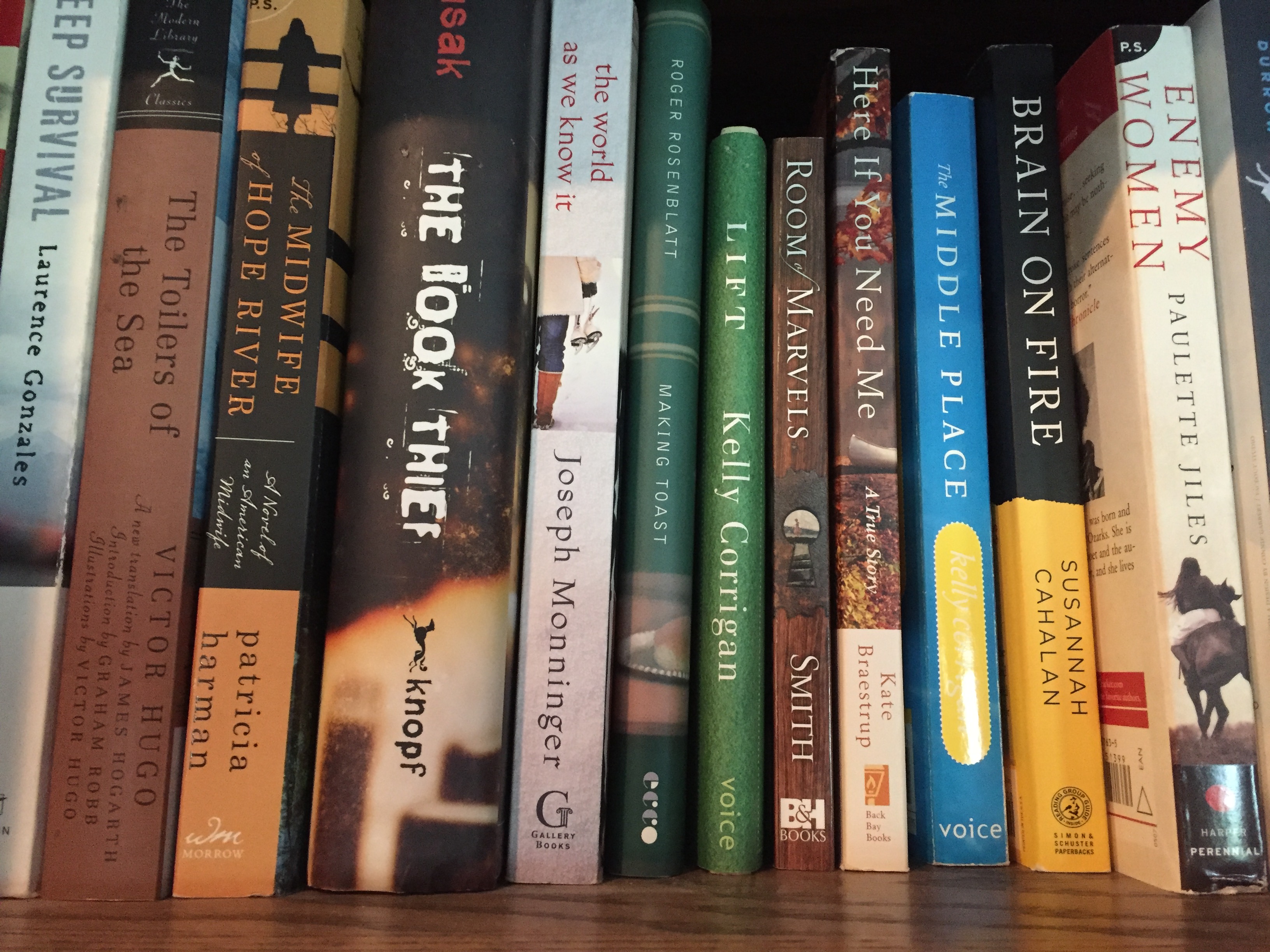As the fourth of five siblings, most of my childhood books had already been well-loved by the time they came to me. Covers, if they remained at all, were worn and tattered, often with some words rubbed off altogether. My parents’ shelves were lined with classics, all with identical green and gold covers, designed to look swell on display.
In middle school, we were instructed to cover our textbooks with folded paper bags from the grocery store, which provided blank canvases for doodling in class. Later, we learned to camouflage Flowers in the Attic or Wifey so we could read such contraband without parental interference. My formative reading experience was with books from the local library, their jackets wrapped in annoying crinkly cellophane secured to the book with yellowing tape.
Book jackets were either absent or needed to be engineered or endured. I learned not to pay attention to them. Cover art only spoiled the images of characters or places my imagination would create, and reading the pert summaries might reveal too much of the plot.
Titles held the allure for me. They were the beckoning finger, the enticing come hither. Once the title had my attention, if I could make it through the first paragraph with my interest piqued, then I’d give it a go. Happy, sad, horror, mystery, romance–it didn’t much matter so long as the story had a decent pace and the plot wasn’t too predictable. A book’s jacket, if it had one, was useful as an impromptu page marker at best.
Turns out, I may be an anomaly. Apparently, second only to favorite author, jacket copy is the next most important factor in the average person’s book purchase. Plus, most people don’t want to work that hard to figure out what a book is about. Who has time to read an opening paragraph or even a whole chapter to sample an author’s voice and style when you can make a quick judgment based on crafted adjectives and celebrity reviews?
Of course there’s a wealth of talent and creativity in those who design cover art and word jacket summaries! Clever design and painstaking art are beautiful in their own right. Many covers can stand alone as frame-able. Distilling a novel to its essence in just a few enticing sentences can be insanely difficult. And woe to you if you mislead the reader, billing a plot as horror when it’s more suspense or thriller. Forgiveness comes slowly. Despite an entire industry devoted to them, jackets are advertising: show and spin, designed to turn heads. The meat lies within.
We are a fickle species, our attention diverted by sparkle, shine, the new, and the next. Witness the trend of movie tie-in covers, which may generate additional buzz, but for purists who know the movie is rarely (never?) as good as the book, are insulting. Plus, I don’t need Daniel Radcliffe’s face staring at me from my nightstand, thank you. That’s what Google’s for.
An accidental experiment: While writing this post, the book I’m currently reading (The Secret Chord by Geraldine Brooks) sat on the counter, sans jacket, just a plain dark brown cover. My teenage son, who despite my best efforts would rather eat an entire can of beets than read (et tu, Brute?), repeatedly picked it up and thumbed through it, almost without realizing it. When I asked why he kept being drawn to my book, he said it was because it had no cover and he wanted to see what it was about!
It was a mystery, an invitation to explore, which is what books are all about in the first place. When it’s all done for you, laid out in bold type on the cover, maybe it steals some of the discovery. When we were young, my mother would occasionally bring home a case of discount canned goods with no labels. Sometimes you’d get pickled asparagus, but sometimes you’d get your favorite. I guarantee it made dinner that week an adventure!
Am I a book jacket curmudgeon, shaking my cane at the bright and shiny displays lining the entryways of bookstores? Perhaps. But maybe jackets shouldn’t be abandoned totally. Juniper Books, based in Boulder, manufactures custom jackets on a large-format printer to create unique and artistic book displays. What if bookstores displayed Jack London’s works like this, using murals based on some of the themes in his novels.
Maybe it wouldn’t be 100% practical, but wouldn’t it be interesting to look for books on politics in a section shelved like this?
There’s no denying the whimsy and visual effect!
Maybe book jackets are essentially costumes. We have been conditioned to pay no attention to the guy with the crooked necktie and thick-rimmed glasses. He may be Mr. Right, strong, faithful and affectionate, but he looks like everyone else. When he steps into that phone booth and dons a pair of tights and a bodysuit emblazoned with a giant “S,” we sit up and take notice. Same guy–he was there all along–but it took some primary colors and bold type to show us Superman was in our midst. From now on, they’re not book jackets. I’m calling them Book Capes.











Book capes. Love it. And I can’t get the image of you shaking your cane at bright book covers out of my head. LOL
Great article, I must confess while the cover image has to do something for me, I will give a book a try even if the cover is awful but the blurb is right. I almost never go on reviews or praise scrawled across the front by someones whose opinion I care little about.
But I can appreciate your sentiment as I treat movies in a similar way you describe 20 seconds of trailer is enough to tempt me – any more and it reveals to much and the movie poster doesn’t have to be great either.
I find it so interesting that your son kept picking up the book that didn’t have a cover on it. And I wasn’t aware of Juniper books and their book jacket printing. I’m definitely going to check that out. Will be interesting to see what they offer.
Wonder what a world would be like WITHOUT book covers. What if books were a solid color with JUST the author’s name on it. No title, no pictures. Just J.K. Rowling #1, J.K. Rowling #2, J.K. Rowling #3 . . .
It USED TO BE a world without book covers, right? Before mass printing, you either had the small school primers and libraries like the one at Trinity College in Dublin, all leather bound and gilt edges. I kind of have a thing for vintage everything, so maybe that’s why I prefer coverless. 😉
We’re told that when we meet a new person we make up our mind about them in about 3 seconds, and maybe browsing books is the same. I’m intrigued, though, that your son was more attracted to the “mystery” book due to its lack of cover. And personally, I’m definitely drawn to books where the cover doesn’t bash me over the head with the content. I like to work a little to figure out why a cover was chosen, and am always intrigued by the use of different covers for different countries / markets.
First impressions are definitely a thing. They’re often wrong, though, or based on the wrong thing. I’m trying to consciously do that less–with people AND books! Like you, i do like the covers that leave a little mystery.
That custom jacket cover set is really really cool and the fact that attention is drawn only to the cover rather than the content represents exactly how we function as humans
I love hardcover books and I’m actually more inclined to read the jacket cover than a back blurb. Is that weird or what? When I read a hardcover I always take the jacket off to protect it 🙂